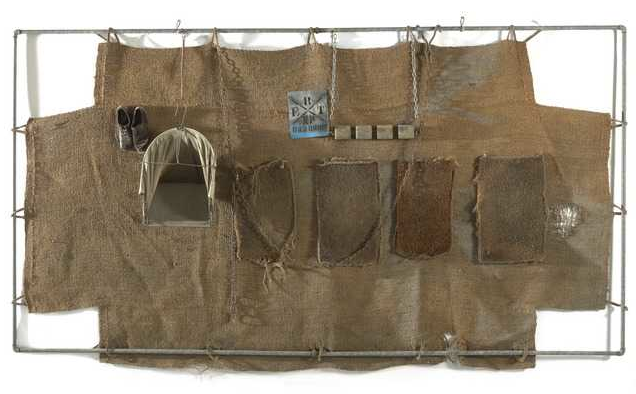Art News New Zealand, Autumn 2012.
In the early 1980s, as a member of Elam’s art-criticism class, I visited a Don Driver show at Auckland’s RKS Art. Our lecturer, Alberto Garcia-Alvarez, subjected the work to a narrow formalist reading. He praised Driver’s collaged hangings for their taut arrangements of shapes, colours, and textures, but refused to address their suggestive imagery (their ‘pockets’ and ‘tools’). However, such ‘content’ was all the class—being versed in Roland Barthes and feminism—wanted to discuss. As I see it now, both parties were equally right, equally wrong, and our standoff was an expression of the work itself.
Driver is popularly associated with New Plymouth. He moved there as a boy and spent the rest of his life there, working at New Plymouth’s Govett-Brewster Art Gallery from 1969 to 1992. In the 1960s, Driver started making assemblages by collaging found materials. Although, in the early 1970s, he made some pure abstract paintings, he ultimately rejected pure abstraction, preferring to use found materials that carried complicating real-world associations. His materials—including tarps, forty-gallon drums, sacks, agricultural tools, and animal hides and skulls—were keyed to the distinctive rural-industrial New Plymouth environment. While the pantheistic painter Michael Smither became famous for celebrating Taranaki’s natural beauty, Driver spruiked its utilitarianism and vulgarity. He was the anti-Smither.
Driver produced a range of work. Lawn Cuttings (1976) brings together a dilapidated coir mat, a stained canvas grass-catcher, exhausted doormats, a wooden roller, a chain, a stencil plate, and a friend’s string-laced shoes in a painterly texture study. Ladder (1978)—a ladder supporting a plywood ‘ceiling’ that makes it impossible to climb—owes something to Magritte’s conceptual paradoxes. Improvised from a plank, a sheet of yellow plastic, and part of a Shell Oil sign, the secular With Spirit (1978) is a verbal-visual non sequitur. Combining a pageant of garish synthetic dresses, pitchforks, and ‘dried blood’ and ‘produce’ sacks, Driver’s hanging Produce (1982) suggests a backdrop for a patriarchal rural fertility cult, albeit one drained of any The Wicker Man poetic pretensions.
Driver’s best-known work is his installation Ritual (1982), commissioned by the National Art Gallery, Wellington. It features a team of modern/primitive fetish figures—animal-skullheaded dolls, bearing tools (including scythes, pitchforks, a lamp, and a signal mirror), and exposing their enlarged genitalia. They stand vigil upon forty-gallon drums, on a dray, surrounded by hay, accompanied by an ominous soundtrack. The Govett-Brewster wanted to buy it, but the powers-that-be dithered. Years later, with the artist threatening to take Ritual to the tip, the National Art Gallery stepped in, securing it for a song.
Ritual is Driver’s best-known work, but it isn’t his best work. Driver’s best works are neither lucid tableaux like Ritual nor the pure abstractions, but the works that crash formalism and ‘content’ to create interpretative dilemmas for the viewer, like his 1988 Wellington City Art Gallery installation, Boxes. Driver painted the walls yellow, orange, and red, stacked grotty old drink crates against them, and dimmed the lights. Magazine-cover posters covered the floor, so you literally walked over faces, mostly women’s. It felt like a warehouse, basement, or some other rancid, femininity-free male preserve. A central column was neutralised by being clad in mirrorglass, which both made (male) viewers self conscious and suggested (female) preening. Women Against Pornography (WAP) complained that Boxes was sexist. However, the work’s insight was in implicating WAP in making the very associations it wanted to condemn Driver for making, while leaving his champions free to argue that it was not attacking women but sexist representations of them, or that the ‘boxes’ referred not to vaginas but to dogmatic minimalism—perhaps Driver’s true adversary.
Driver never fitted into anyone else’s big picture. Although primarily a sculptor, he was often seen alongside mainstream painters: he was included in Ten Big Paintings (Auckland City Art Gallery, 1971) and Jim and Mary Barr’s book Contemporary New Zealand Painters A–M (1980). For a moment, he was even championed by abstract-painting guru Peter Vuletic. Driver also had a toehold in the alternative, post-object art scene: he featured in the New Art anthology (1976) and showed at Mildura Sculpture Triennial (1978) and F1: New Zealand Sculpture Project (1982). Through the 1980s, with the battle lines drawn between internationalist-modernist-abstraction and nationalism, Driver’s funky regional modernism proved impossible to position, so he was sidelined in the argument. His marginal position was enhanced by his being an out-of-towner, by his man-of-few-words reticence, and by his button-pressing sexual politics. While favoured by institutions (Auckland Art Gallery, Te Papa, and the Govett-Brewster have deep holdings), Driver never had much market profile; his works were perennially neglected by rank-and-file private collectors. This was their loss, as Driver made some of the most iconic works of New Zealand art of his time.
Sadly, now, Driver exits the stage, well known but surprisingly undervalued, albeit ripe for rediscovery.
.
[IMAGE: Don Driver Lawn Cuttings 1976]
